- Preface
- Acknowledgements
- Chapter 1: Welding Overview
- Chapter 2: Safety
- Chapter 3: Terms, Joints, & Edge Preparation
- Chapter 4: Tools & Welding Tables
- Chapter 5: Shielded Metal Arc Welding
- Chapter 6: Wire Feed Welding
- Chapter 7: Gas Tungsten Arc Welding
- Chapter 8: Oxyacetylene
- Chapter 9: Controlling Distortion
- Chapter 10: Cutting Processes
- Chapter 11: Brazing & Soldering
- Chapter 12: Common Problems & Solutions
- Chapter 13: Design Tips
- Chapter 14: Fabrication & Repair Tips
- Chapter 15: Tools & Tooling
- Chapter 16: Pipe & Tubing
- Chapter 17: Metallurgy
- Chapter 18: Power Supplies & Electrical Safety
- Chapter 19: Bending & Straightening
- Index
- Credits
Chapter 13
Design Tips
Success is the result of countless failures you’ve done in order to attain it.
—Mark Aaron A. Corrales
Introduction
Like a chain, a part is only as strong as its weakest link. To assure the quality of a part, keep the function of the part in mind when designing welds and remember that welding is not the answer to every metal joining problem. Try to avoid unnecessary welds by incorporating small castings, forgings, or standard sections whenever possible, and use bending, rolling and flanging to add strength without adding weld metal. Also, place welds in sections with lower stress concentrations and make sure the weld design has no stress-inducing notches which could lead to fatigue failure.
Good Weld Characteristics
A good weld design meets the following four criteria:
- Strength – A weld should satisfy the strength and stiffness requirements of the part, but must not be over designed. If in doubt, have engineers check the part for safety. They may discover that the stiffness requirements are set too high; an error which costs money in extra material, welding time, handling and shipping. Over design may also impose added long-term costs on the end user in fuel consumption and maintenance.
- Rigidity – Use thick sections to resist bending. Symmetrical sections are more efficient for bending resistance.
- Appearance – Specify the appearance required on the welds to avoid unnecessary grinding and finishing. Appearance for its own sake usually increases cost and is not necessary when welds are completely hidden from view. The welder is not likely to know which welds are critical appearance-wise and which are not unless the print specifies appearance.
- Code & Legal Issues – If the product must be fabricated to a code, check to determine that the most economical method currently allowed is used.
Methods to Add Strength
The proper use of stiffeners will provide strength and rigidity with less weight. Here are several ways to add strength:
- Closed sections are used for torsion resistance. Torsional resistance of a frame is approximately equal to the sum of the resistance of its individual parts. Sections that are closed are often several times more torsion-resistant than open sections. See Table 13-1.
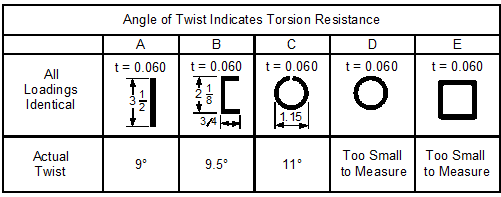
Table 13-1. Five steel shapes and their measured angle of twist when subjected to the same torsional load.
- Diagonal bracing is much more effective than longitudinal or straight-across bracing in resisting torsion. The diagonally braced frame in Figure 13-1 is 36 times more resistant to torsional twist, yet uses 6% less metal.
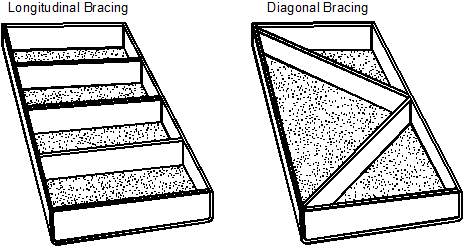
Figure 13-1. Diagonal bracing increases torsional rigidity much more than longitudinal, or straight-across, bracing.
- Vertical stiffeners vs. horizontal stiffeners – As shown in Figure 13-2, vertical stiffeners are not as effective in resisting compressive loads as horizontal stiffeners. The horizontal stiffeners provide more support along the length of the box. This reduces the length of the intervals along the sides of the box not supported by stiffeners.
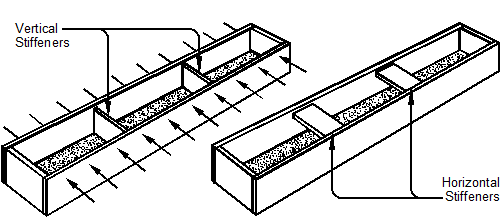
Figure 13-2. Vertical stiffeners (left) are not as effective in resisting compressive loads as horizontal stiffeners (right).
- Vertical bracing is not as effective as diagonal bracing. Vertical or longitudinal stiffeners must be used in castings because of coring constraints, while horizontal stiffeners can be used in a welded design. Figure 13-3 shows two welded steel machine bases. When both bases are subjected to torque of 1000 in-lb, the base on the left with vertical bracing twists 1.84º while the base on the right with diagonal bracing twists less than 0.001º.
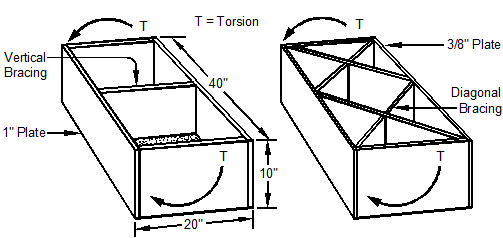
Figure 13-3. These two box frames have the same rigidity despite the thinner plates used to make the diagonally reinforced box on the right. Diagonal bracing is often used in machine bases because it is more rigid than vertical bracing.
Construction Considerations
With a little planning, parts cannot only be made stronger, lighter and quicker, they can also cost less and be easier to maintain. Here are some examples:
- If only the surface properties are needed, such as wear-resistance on a high-priced or difficult-to-weld material, consider using a mild steel base and hardfacing—which means adding hard-as-welded filler metals in critical areas only.
- Adding hardened parts, such as dowel pins, in critical areas only is an economical alternative to an entirely hardened part. See Figure 13-4.
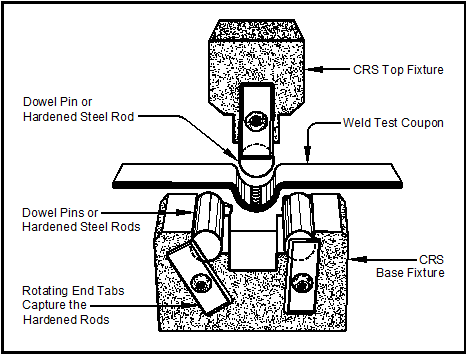
Figure 13-4. Adding hardened stock to only the critical areas of this weld-test fixture—the areas that really require extra hardness—saves on materials and heat-treatment costs.
- Dimension parts so that the plate and bar sizes can be easily obtained from your in-shop stock or from a vendor’s in-house inventory. Do not specify a special-order size unless absolutely necessary. Try not to design parts that require unobtainum.
- Round parts can replace square ones, as in Figure 13-5, so that a rotary welding table can be used. Welding on a rotary table has one starting and stopping point and no corner welds, so it is not only easier on the welder because torch movement is minimized, it reduces the number of potential failure points where weld defects can develop.
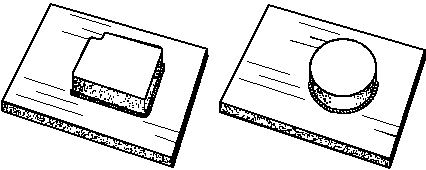
Figure 13-5. Re-designing a shape to accommodate welding on a rotary table.

